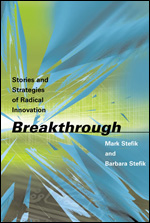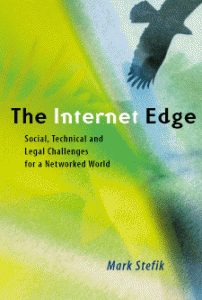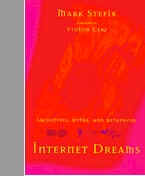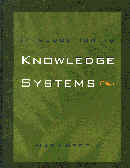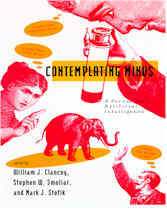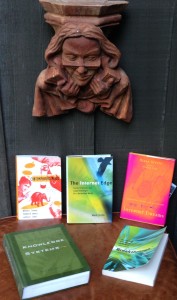 Every now and then I am moved to write at length and publish my ideas in an area where I have been working. The writings range from the technical — such as my computer science textbook on knowledge systems to thoughts about the practice of innovation from my work as an inventor and research fellow at PARC. The books are arranged below with the most recently published books first.
Every now and then I am moved to write at length and publish my ideas in an area where I have been working. The writings range from the technical — such as my computer science textbook on knowledge systems to thoughts about the practice of innovation from my work as an inventor and research fellow at PARC. The books are arranged below with the most recently published books first.
Below you can find links for accessing these books on the web via Google Books and also for getting paper copies. Some of the books are available in languages besides English as noted.
Stefik, M. & Stefik, B. (2004) Breakthrough: Stories and Strategies of Radical Innovation. Cambridge, Massachusetts. The MIT Press.
In the early 2000’s I led the Information Sciences and Technologies Lab at PARC. I had had some success as an inventor and knew how I approached that craft. Taking on the leadership of a research laboratory I wanted to understand better the practices of many others and also about effective ways to create commercial successes. My work life became “sitting in the fire” by day with the demands of running a laboratory, and reflecting on its lessons in the evening writing the book. Together with my wife, we interviewed inventors, entrepreneurs, and others in the innovation ecology to understand the best practices of invention and innovation. The book is about fostering invention and innovation and is based on interviews with repeat inventors and leading innovators from across Silicon Valley and elsewhere. Also available in Japanese and Ukranian, it has the following chapters:
I. Invention and Innovation
- Chapter 1. The Breakthrough Dilemmas
- Chapter 2. The Dance of the Two Questions
- Chapter 3. Invention: Seeing Differently
- Chapter 4: Innovation: The Long Road
II. Fostering Invention
- Chapter 5. Mentoring and Apprenticeship
- Chapter 6. The Prepared Mind and the Aha! Moment
- Chapter 7. The Beginner’s Mind and Play
- Chapter 8. Walking in the Dark
III. Fostering Innovation
- Chapter 9. Innovative Research Groups
- Chapter 10. Obstacles to Radical Innovation
- Chapter 11. Cultures of Innovation
- Chapter 12. Innovation at the Crossroads
Stefik, M. (1999) The Internet Edge: Social, Technical, and Legal Challenges for a Networked World. Cambridge, Massachusetts. The MIT Press.
My research on computer systems has engaged me with many issues that are taking new shape and importance on the web, including on ubiquitous computing, trusted systems, copyright, knowledge networks, privacy, and other matters. This book grew out of my reflections in the late 1990’s on the future of the Net. It is about social, legal, and technological challenges for a networked world. It has the following chapters:
- Chapter 1. The Internet Edge. Change and Connections.
- Chapter 2. The Portable Network. Away from the Desktop and Into the World.
- Chapter 3. The Digital Wallet and the Copyright Box. The Coming Arms Race in Trusted Systems.
- Chapter 4. The Bit and the Pendulum. Balancing the Interests of Stakeholders in Digital Publishing.
- Chapter 5. Focusing the Light. Making Sense in the Information Explosion.
- Chapter 6. The Next Knowledge Medium. Networks and Knowledge Ecologies.
- Chapter 7. The Edge of Chaos. Coping with Rapid Change.
- Chapter 8. The Digital Keyhole. Privacy Rights and Trusted Systems.
- Chapter 9. Strangers in the Net. Access, Diversity, and Boundaries.
- Chapter 10. Indistinguishable from Magic. The Real, the Magic, and the Virtual.
Stefik, M. (1996) Internet Dreams: Archetypes, Myths, and Metaphors. Cambridge, Massachusetts. The MIT Press.
I wrote this book in the mid-1990’s when the primary metaphor for describing the internet was the “information superhighway”. Recognizing that metaphors shape how we understand things, I selected some of my favorite essays people who have thought deeply about the future of computing and organized these writings according to four main metaphors: The Digital Library, Electronic Mail, The Electronic Marketplace, and Digital Worlds. The book explores the meanings, the possibilities, and the limitations inherent in each of these ways of looking at what the internet may become. Contributors to the book include: John Browning, John Seely Brown, Vannevar Bush, Vint Cerf, Harry Collins, Scott Cook, Pavel Curtis, Julian Dibbell, Samer Faraj, Laura Fillmore, Robert E. Kahn, Joshua Lederberg, J.C.R. Licklider, Ranjit Makkuni, Tom Malone, Vicky Reich, Lee Sproull, Mark Stefik, Barbara Viglizzo, Mark Weiser, and William Wulf. (Also available in Japanese and Italian)
Stefik, M. (1995) Introduction to Knowledge Systems. San Francisco, California. Morgan Kaufmann Publishers.
In the early 1990’s the main successes of artificial intelligence were knowledge systems. It was difficult to separate the hype from the real promise. No textbooks covered the theory and practice of building knowledge systems. I developed this textbook over five years while teaching a course at Stanford University on Knowledge Systems. The course was taken by graduate and advanced undergraduate students. It is about the principles and practice of building knowledge systems.
PART I FOUNDATIONS
- Chapter 1. Symbol Systems
- Chapter 2. Search and Problem Solving
- Chapter 3. Knowledge and Software Engineering
PART II. THE SYMBOL LEVEL
- Chapter 4. Reasoning about Time
- Chapter 5. Reasoning about Space
- Chapter 6. Reasoning about Uncertainty and Vagueness
PART III. THE KNOWLEDGE LEVEL
- Chapter 7. Classification
- Chapter 8. Configuration
- Chapter 9. Diagnosis and Troubleshooting
Clancey, W.J., Smoliar, S.W., & Stefik, M. (1994) Contemplating Minds: A Forum for Artificial Intelligence. Cambridge, Massachusetts. The MIT Press.
Stephen Smoliar and I edited the book reviews column for Artificial Intelligence for several years. We picked some of the more controversial books being published in Artificial Intelligence and invited reviews often from people from several different disciplines. Bill Clancey approached us with a book proposal in 1994, observing that many people were using the reviews in AI courses. The book is organized in four sections: symbolic models of mind, situated action, architectures of interaction, and memory and consciousness. It includes reviews of illuminating and controversial books from the 1980′s and 1990′s by Daniel Dennett, Gerald Edelman, Bernardo Huberman, Marvin Minsky, Robert Ornstein, Allen Newell, Donald Norman, Steven Pinker, Z.W. Pylyshyn, Israel Rosenfield, William Seager, Lucy Suchman, Herb Simon, and Terry Winograd. The reviews themselves are drawn from leaders in the AI and cognitive science communities, often published with a response by the authors. Clancey, Smoliar and I provide interstitial essays to relate the reviews in each section to major themes in artificial intelligence.

